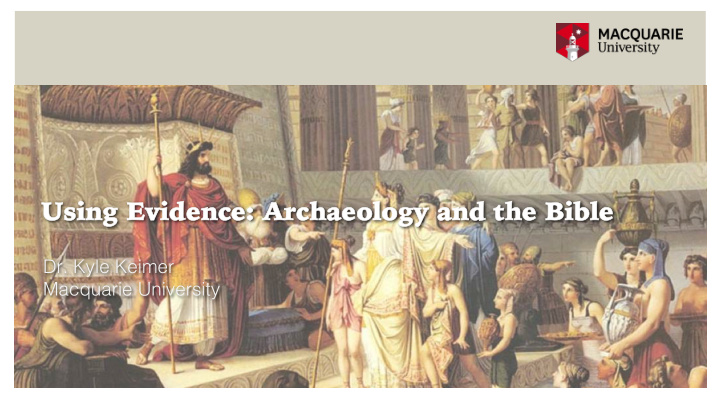



Us Using g Evide dence: Archaeology gy and d the Bible Dr. Kyle Keimer � Macquarie University �
The Israelite United Monarchy When did the events take place? Ca. 1040-930 BC. (the Reigns of Saul, David, and Solomon) Where did they take place? Israel (Israel and the West Bank), Transjordan (Jordan), Aram (Syria) Who wrote about them? Court records, the “Deuteronomist”, the prophets Samuel, Gad, and/or Nathan. Depends on who you talk to What literary sources do we have for an event/personage? Dan Stele What archaeological material is there? Also depends on who you talk to
Approaches to the Israelite United Monarchy From the Biblical Sources a. Pre-1980s: Biblical account of UM a sound reflection of history b. 1990s to Present: Biblical account of UM considered increasingly useless for establishing accurate view of the UM (if there was one)
Approaches to the Israelite United Monarchy “…the House of David…” “…the House of [D]avid…” The Mesha Inscription (9th c. BC) The Tel Dan Inscription (9th c. BC)
Approaches to the Israelite United Monarchy From the Archaeological Material a. Pre-1996: Archaeology generally supports view of UM in the Bible and has much material correlation b. Post-1996: Questionable association of material culture to the 10th century BC and the UM vs. Traditional ascription of material to the UM Megiddo Gezer Hazor
The Quest for King David What “footprint” did David leave? � Ideology Texts Geography Archaeology
RECONSTRUCTING HISTORY - A LAYERED APPROACH CONTEXT Biblical Texts Ancient Near Eastern Sources Archaeology Geography Geology
RECONSTRUCTING HISTORY - A LAYERED APPROACH Biblical Texts Ancient Near Eastern Sources Archaeology Geography Geology
The Early Israelite Monarchy in Text and Archaeology The Days of Saul, David, and Solomon What does the Biblical text actually say? Saul Unifies the tribes of Israel, builds an altar (1 Sam 14:35) David Starts as warrior, wins support of Judah, reigns from Hebron, wins support of “Israel”, makes Jerusalem his capital, builds the “millo and inward” (2 Sam 5:9; 1 Chr 11:8) and an altar (2 Sam 24:25; 1 Chr 21:26), battles neighbors and wins, rules via treaty/ vassaldom/prefects Solomon Inherits father’s kingdom, exploits northern tribes, intensifies administration, Solomon is wise, powerful, wealthy, “builds”: Jerusalem – his house, the Temple, the wall of Jerusalem (1 Kgs 3:2; 9:15), the House of the Forest of Lebanon (1 Kgs 7:2), the “millo” (1 Kgs 9:15, 24), a house for Pharaoh’s daughter Hazor, Megiddo, Gezer, Lower Beth Horon, Baalath, Tamar/Tadmor, store cities, chariot cities, cities for his horsemen, and whatever he desired to build in Jerusalem, Lebanon, and in all the land of his dominion (1 Kgs 9:15-19; cf 2 Chr 8:1-11)
The Early Israelite Monarchy in Text and Archaeology The Days of Saul, David, and Solomon When was the Biblical text written? Date of � Historical � Authorship: � Writing: � Date: � ? � 10-6th c BC? � Ca.1040-970 BC � • 1 Samuel 8 - 2 Samuel 24 ? � 10-6th c BC? � Ca.970-930 BC � • 1 Kings 1 - 1 Kings 12 ? � 4th c BC? � Ca.1040-930 BC � • 1 Chronicles 10 - 2 Chronicles 9
The Early Israelite Monarchy in Text and Archaeology The Days of Saul, David, and Solomon The United Monarchy in Archaeology Iron Age I Iron Age IIA What do we see in the archaeology? 1000-925 BC • Bible and Archaeology 1200-1000 BC ca. 930-830/800 ca. 1130-930 • Low Chronology Saul ca. 1180-980 ca. 980-830 • Modified Conventional Chronology Gibeah (Tell el-Ful) David Jerusalem Str 15, Kh. Qeiyafa, Kh. el-Rai Reconstruction of Jerusalem from the days Solomon of Solomon Jerusalem – the Ophel : The Far House (Building Ia+b), the Great Projecting Tower (Building II), the Gatehouse complex, the “Royal Building”, the “Straight Wall” (Wall IV), Wall V (casemate)? Hazor X-IX – City gate, casemate wall Megiddo VA-IVB – City gate, casemate wall, Palace 1723, Palace 6000 Gezer VIII – City gate, casemate wall, Palace 10000 Tamar (En Hazeva), Negev “Forts”, Horbat Rosh Zayit IIb, Arad 12, and many more
Assumptions and/or Accepted Views Ancient Israel was a “State” and it can be identified archaeologically by the presence of specific traits identified through comparative studies and associated with social complexity Israel’s political organisation was bureaucratic Jerusalem, Israel’s capital, should be a large and prosperous city to match the complex political/administrative structure Monumental architecture and writing go hand-in-hand with political complexity and should be expected in ancient Israel David, and particularly, Solomon, ruled an ’Empire’
Challenges to the Assumptions and/ or Accepted Views Ancient Israel was a “State” and it can be identified archaeologically by the presence of specific traits identified through comparative studies and associated with social Only the case if the following are true, which they are not complexity Israel’s political organisation was patrimonial Israel’s political organisation was bureaucratic Jerusalem, Israel’s capital, should be a large and prosperous city to match the Size does not equate to reach complex political/administrative structure Monumental architecture and writing go hand-in-hand with political complexity and Not if there is no sense of private/public or bureaucracy should be expected in ancient Israel ‘Empire’ is an inappropriate term David, and particularly, Solomon, ruled an ’Empire’
Using Evidence: Archaeology and the Bible The Israelite United Monarchy Conclusions 1. Use an appropriate theory for understanding the ancient Near East and ancient Israel in particular. Understand the context. 2. Match our expectations to our theory 3. A reading of the biblical texts must be attuned to a given text’s genre, our hermeneutics, and the available comparative ancient literature 4. Interpretation of the archaeological remains requires a theoretically informed hermeneutic so the best model of ancient society can be allowed to speak for itself (as much as possible) 5. When points 1-4 are considered, many disparities noted by biblical scholars and archaeologists become resolvable 6. When points 1-4 are considered, a literarily viable, historically reliable, and archaeologically verifiable portrait of the United Monarchy is possible.
Recommend
More recommend